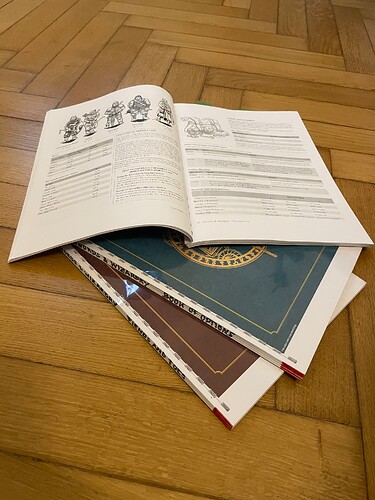Once again late to the party, but here are my recommendations for bookbinding supplies, roughly in the order you should get them, IMO.
The absolute basics:
- Paper
- Thread & Needles
- Glue (Preferably PVA, but there are people out there binding books with hot glue, so you do you.)
You probaby have all of those at home and none of them have to be fancy. For paper, most of my books are bound using your average copy/printer paper. 80gsm, bright white, cheap as dirt. Thicker paper is nice for zine or softcovers. One thing that does make quite a difference in the result: Become aware of grain direction in paper/cardboard. There’s a whole, very informative video on this, but the short is that most copy paper you’ll find is longgrain, which makes it right for smaller, A6 books, but wrong for A5 sized zines. Don’t get me wrong, it still works for those, but the result will drape less well.
For beginning you can just use whatever, tho. (“Perfect is the enemy of good” and all that.)
Same with thread and needles: You don’t need anything fancy, though you probably want a slightly thicker thread than the kind you use for machine sewing. (People have successfully used dental floss and embroidery thread, for example.) You probably want something without much stretch and maybe sewing needs that are on the bigger side.
With the above, you can bind brochures, do stab binding (if you have something that can punch holes), technically you could even do perfect binding with those, depending on what kinda glue you have. Most people can bookbind with stuff they have in their home RIGHT NOW.
The almost-essentials:
- Bonefolder (Or something else to fold with)
- Awl (Or something else to stab holes with)
- Grayboard (Or some heavier cardboard, laminated cereal boxes, …)
- Metal Ruler (Or a plastic one if you’re careful)
- Cutter/Knife/Stanley Blade (Or whatever you use to cut straight lines with a ruler)
- Cutting Mat (Or scrap cardboard, or a piece of wood you don’t care for, or whatever)
- Something Heavy (I mostly use a stack of rpg hardcovers and a jar filled with pennies.)
- Glue Brush (I use an old bristle brush, but you can use a scraper, a roller or those sponge brushes as well.)
Moooost of those are easily replicable with hosehold objects, but sometimes dedicated tools are nice to have. (Also, many people have some of those things already, like a cutting mat, some kinda craft blade, or an awl if you do leatherwork.)
With the above and some judicious application of fuck-around-find-out, you can do most book structures, at least in some way. They might not last for decades or centuries (lack of bookcloth is the issue here, though one can make their own at this level) or look the neatest (for example trimming the edges of thicker books is a challenge), but they with be real, actual, physical books, usable and sturdy.
If you find bookbinding to your liking and/or want to invest a bit of money, you can get into:
The amazing-to-have:
- Glue and Paste
- Bookcloth
- Paper With The Right Grain Direction
- Printer
- Come kinda copyshop/well-stocked library/ smal scale print-shop in your area
Glue-wise, you probably want to have some kinda PVA glue (archival/acid free, preferably) and some kinda paste. Starch paste, wheat paste, methyl-cellulose, whatever. The former you have to buy, the latter you can buy or make your own. Having two kinda of sticky stuff is very useful in a lot of bookbinding areas.
Bookcloth, cloth either filled with medium or backed with paper, to stop glue from striking through, is probably the specialized bookbinding thing I’d get first. It just make a difference in feel, makes for sturdier books and has some specialised applications that are pretty useful. You can make your own, but commercial ones isn’t absurdly expensive, though it can a bit difficult to find, needing art supply shops and stuff.
Correctly grained paper doesn’t have to be expensive, but often is if you buy it pre-cut. Buying larger sheets and then cutting them down to the propper grain direction is often cheaper, depending on how much you value your own time. The absolute cheapest way is buying A3 copy (generally shortgrain) and then cutting that down to shortgrain A4 (two cuts using your friendly neighborhood copy shops hydraulic cutter), but that results in lots of offcuts. (Useful if you want to make smol blank notebooks or do papermache, though.)
Printer-wise: Whatever printer you have is fine. Laser is nice because it’s fast and the resulting print is lightfast and waterproof, but inkjets are perfectly ok as well. (Depending on how much you print for binding and how much is color, if might get expensive, tho.)
Even if you have a printer, I highly recommend looking into copy shops, print shops etc in your area. They are super useful to the home bookbinder. You can of course print your stuff there and then bind them at home, but perhaps more important is the fact that they almost always have a hydraulic paper cutting machine! Which means that they can trim your textblocks for you, can cut down stacks of larger paper to your specifications or cut board to size, in my experience for not much money. (Most charge some small amount per cut, like 50cts or 1$/€.)
And if you have allll those, are still really into bookbinding or have too much money, you can get a finishing press or something, I dunno. I think at this point you would have a good enough idea of what interests you in bookbinding and where you want to go next that you don’t need me to tell you stuff.


